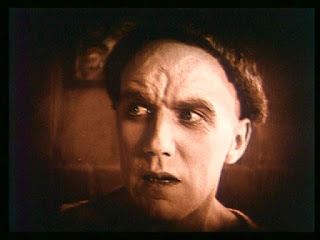Häxan a.k.a Häxan: Witchcraft Through the Ages a.k.a The Witches
Aljosha Production Company, Svensk Filmindustri, Sweden, 1922.
Benjamin Christensen's cult film "Häxan" is a historic-cultural lecture in seven parts.
The first part tells about ancient world views. The evils in the world were thought to be caused by evil spirits and demons. The witches were thought to be in allegiance with Devil.
 |
| Witch has enchanted a man's shoe |
Second part depicts a witch boiling various magic potions in her dwelling. Grave robbers bring her raw ingredients i.e. corpses of executed criminals. One customer orders a love potion. Elsewhere physicians also do some grave robbing to study the anatomy of human body. They are mistaken as witches. Poor old witch Apelone (Wilhelmine Henriksen) dreams of flying to Devil's castle and attending a witches' gathering.
 |
| Witch in her house |
 |
| Some incredients are not fresh |
 |
| Physicians beginning an autopsy |
Third part shows the witch judges starting a witch hunt. Fear and superstitions made people believe in weird things. People saw witches and devils everywhere. Anna (Astrid Holm) accuses an old woman Maria the Weaveress (Maren Pedersen) of putting a spell on his husband who is now dying. The Pater Henrik (Johannes Andersen) orders a witch hunt. The inquisition arrests the old woman.
 |
| Finding out if a man has been cursed |
 |
| Pater Henrik, Witch Judge |
 |
| Maria the Weaveress is arrested a witch |
Fourth part shows the torture and interrogation of the accused witches. While tortured the old woman confesses fantastic sins such as flying to attend the Black Sabbath and kissing Devil's butt. Facing a death on a stake she also pulls some of her enemies with her including those who first accused her.
Fifth part: every accused witch has informed ten other witches. Many families have lost their family members. Those who oppose arresting witches are of course themselves witches.
Young Monk John (Elith Pio) has fallen in love and become obsessed with Anna's sister (Karen Winther) so naturally she must be a witch. After purging the town of "witches" the inquisitors move to next town.
 |
| Young Monk John |
 |
| Monk tries to make Anna's sister confess |
 |
| Anna's sister |
Sixth part examines further reasons for accusitions. Some of the witches' confessions are completely absurd. Sometimes people practicing folk magic and natural healing were thought to be witches.
Tools of torture chamber are examined more closely. Who wouldn't confess the most preposterous things when tortured? In nunneries nuns torture themselves for mortification of the flesh. The religious fervour causes many nuns to go crazy. They begin to see devils and commit blasphemous acts.
Tools of torture chamber are examined more closely. Who wouldn't confess the most preposterous things when tortured? In nunneries nuns torture themselves for mortification of the flesh. The religious fervour causes many nuns to go crazy. They begin to see devils and commit blasphemous acts.
 |
| Boot torture apparatus |
 |
| Actress test thumbscrews |
 |
| Nun sees the Devil |
Seventh part is set in modern times. Most of the witches were poor old women. In medieval times having a physical deformity or mental illness gave a suspicion of person being a witch. Witch mania has much to do with bad nerves, obsessions or sexual frustrations. Christensen draws parallels to the psychology of the 1920s. With the development of psychology these symptoms were referred as hysteria. Today's people do not fear devils or witches anymore but superstitions still exist. Weirdly acting people are not burned at stake anymore but locked in asylums.
This version is the 2006 Swedish Film Institute restored version that can be found in a DVD collection box "Svenska Stumfilmsklassiker." It contains Matti Bye's soundtrack with musicians Bye, Kristian Holmgren, Lotta Johansson and Lau Nakkarinen. The ambient music works well and brings tragic tones to the dramatic scenes.
Benjamin Christensen found the topic for the film after finding the notorious medieval witch hunting manual Malleus Maleficarum. Christensen spent years 1919-1921 finding source material for "Häxan." It was the the most expensive Scandinavian silent film. The director appears himself as the lewd tongue-wagging Devil. The movie's structure is very unconventional and experimental. The representation consists of lecture type documentary with medieval woodcuts and paintings, acted scenes and some stop-motion animation. The acted scenes with partially intertwining stories combine fantasy, horror and drama. The visual style is impressing with imaginative sets and differently tinted colour filters. The film has a bizarre and unique atmosphere.
 |
| Benjamin Christensen as the Devil |
As the film criticises church's violence against women, it was opposed by Catholic Church and banned in many countries. The dark subject is lightened by occassional dry humour as when a young actress tests thumbscrews. The movies (then) shocking, blasphemous devil worshipping scenes and even raunchy scenes have inspired also the exploitation and nunsploitation moviemakers of the 1970s. However these later movies focused mostly on shock values instead of the social criticism and humanist message of "Häxan."
Starring: Maren Pedersen, Clara Pontoppidan, Elith Pio, Oscar Stribolt, Tora Teje, John Andersen, Benjamin Christensen, Poul Reumert, Karen Winther, Kate Fabian, Else Vermehren, Astrid Holm, Johannes Andersen, Gerda Madsen, Aage Hertel, Ib Schønberg, Emmy Schønfeld, Frederik Christensen, Ella La Cour, Elisabeth Christensen, Henry Seemann, Alice O'Fredericks, Knud Rassow, Ellen Rassow, Holst Jørgensen, H.C. Nielsen, Albrecht Schmidt, Karina Bell, Karen Caspersen, Holger Pedersen
Director: Benjamin Christensen



Yes sir, I like it. Marvelously bizarre, yet thoughtful document.
ReplyDelete